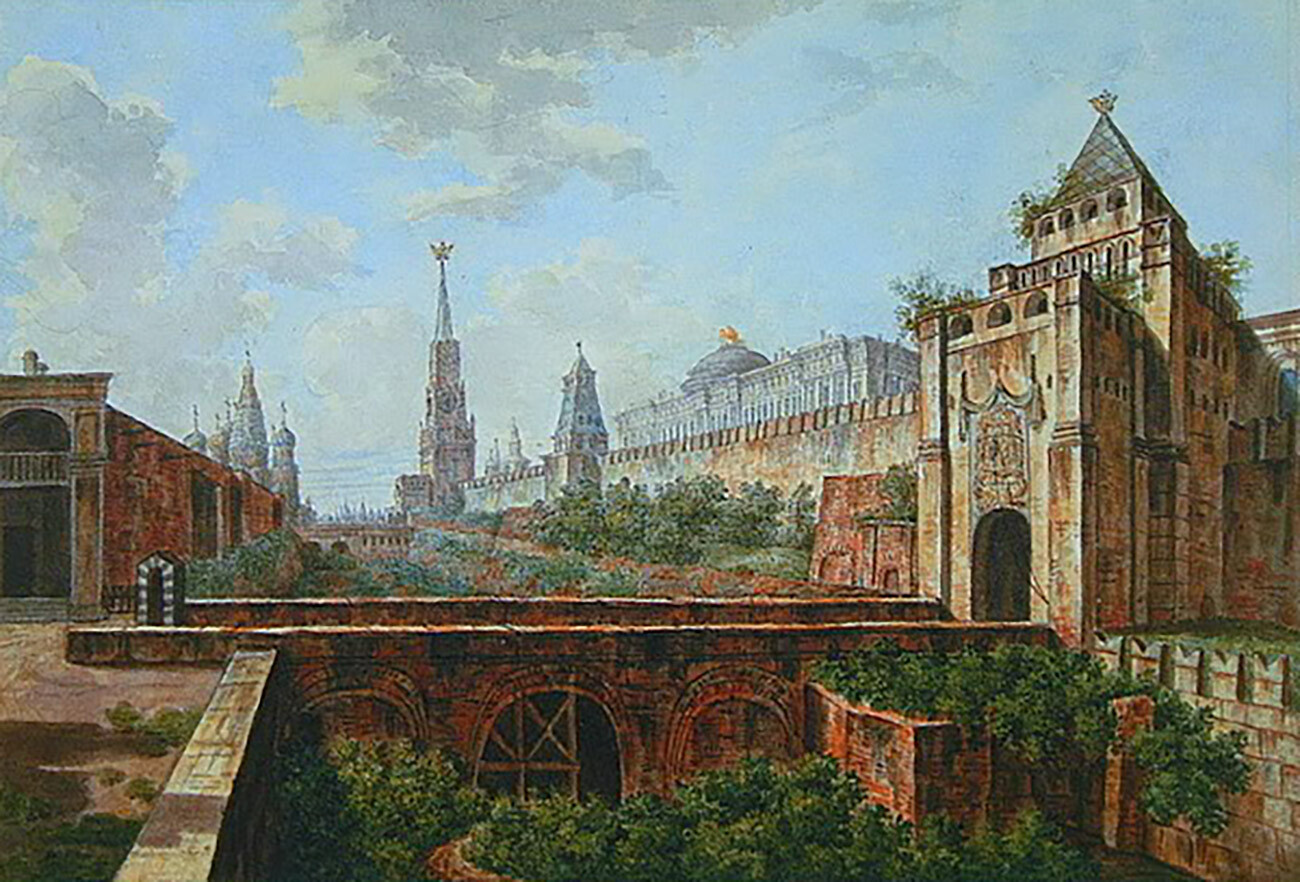Moscow Kremlin through the eyes of Russian artists (PICS)

Fyodor Alekseev, “Alevizov Moat and Nikolskaya Tower”. 1800

Artist Fyodor Alekseev shows the Kremlin from an unexpected angle. Until 1814 there was a fortification moat along its walls, but later it was filled and then a boulevard lined with trees was put there.
Fyodor Alekseev, “Red Square”. 1801

The artist shows a bustling square with trading stalls, as well as the functional Spassky Gate that goes through the tower by the same name, leading into the Kremlin.
Ivan Moshkov, “Moscow. Kremlin. View of the Spasskaya Tower. (View onto the Spassky Gate in the Kremlin)”. 1800-1802

Artist Moshkov gives us a glimpse inside the ancient Kremlin. In the center is the most important tower, the Spasskaya Tower, and to its left is the Ascension Monastery that was demolished in the Soviet era.
Ivan Aivazovsky, “The fire of Moscow in 1812”. 1851

This unusual and non-typical landscape by the famous seascape artist Ivan Aivazovsky shows not the seas that he’s famous for, but rather, another stormy element - fire. Here we see the outlines of the Kremlin against the backdrop of the largest fire in the city’s history that happened during the war with Napoleon. (Read more about who burned Moscow here).
Aleksey Savrasov, “View of the Moscow Kremlin”. 1873

All of Savrasov's paintings are saturated with notions of the untranslatable Russian toska (wistfulness). In his paintings, Nature is always depicted as something sadly wilted, and as realistic as possible. Even the Kremlin is featured against an old fence. But the spring sunshine inspires optimism.
Arkhip Kuindzhi, “Moscow. View of the Moskvoretsky Bridge, the Kremlin and the Pokrovsky [St. Basil’s] Cathedral”. 1882

The Kremlin is the compositional center in this painting, and everything else seems to be graphically outlined around it. As Russia’s leading master of luminosity, Kuindzhi amazingly plays with light and shadow, conveying the shades of a sunny day.
Arkhip Kuindzhi, “View of the Kremlin from the Zamoskvorechye District ”. 1882

This other Kuindzhi painting shows the Kremlin from the other side. Likewise, as in the first case, the main aspect here is not the Kremlin, but the play of light.
Aristarkh Lentulov, “MOSCOW”. 1913

This architectural landscape is a kaleidoscope of buildings and images of Moscow. In the artist's own words, he arranged all of this "motley” and "decorative and luxuriant beauty" around the Ivanovsky Bell Tower of the Kremlin to serve as the central point. Of course, the walls of the Kremlin and the bright colors of St. Basil's Cathedral are easily recognized in these red strokes.
Wassily Kandinsky, “Moscow. Red Square”. 1916

Another Avant-garde artist, Kandinsky, saw the Kremlin directly from his studio windows. He depicted the Moscow “orchestra” of churches, houses, and factory chimneys on canvas.
Boris Kustodiev, “Palm Sunday Market near the Saviour Gate on Red Square, Moscow”. 1917

Fond of genre scenes, Kustodiev depicted Red Square as it has looked for centuries - as a chaotic and colorful haggle, namely the pre-Easter bustle. We can see merchants, gymnasium students, and noblemen in furs. We also get a glimpse of the ornate St. Basil's Cathedral and a part of the Spasskaya Tower.
Apollinariy Vasnetsov, “Moscow Kremlin. Cathedrals”. 1894

The golden domes of the Kremlin cathedrals, which gleam in the sunlight, are one of the most revealing views of old Moscow.
Apollinariy Vasnetsov, “Bookshop on the Spassky Bridge in the 17th century”. 1916

A master of historical landscape, Vasnetsov shows the white-stone medieval Kremlin.
The artist also has a whole series of paintings in which he traces the history and changes of the Moscow Kremlin from wooden and white-stone to red-brick.
Apollinariy Vasnetsov, “Moscow Kremlin under Ivan Kalita”. 1921

“Probable view of the white-stone Kremlin of Dmitry Donskoy. The end of the 14th century”. 1922

“Moscow Kremlin under Ivan III”. 1921

“Rise of the Kremlin. Saints Bridge and the Kremlin at the end of the 17th century”. 1922

Mikhail Bobyshov, “Victory Salute in Moscow, 1945”. 1958

In this aquarelle, light beams reflect the salute and joy of Victory over Nazism, and people pouring into Red Square to celebrate this long-awaited and joyous day.

